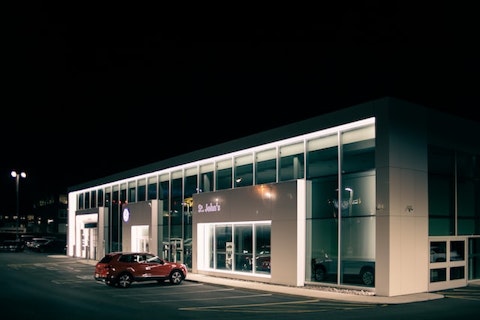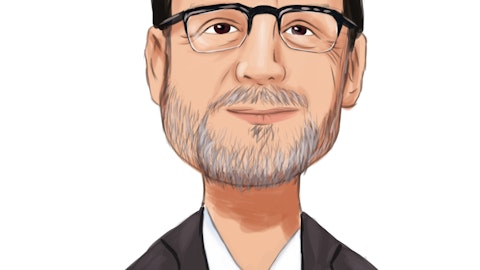America’s Car-Mart, Inc. (NASDAQ:CRMT) Q2 2023 Earnings Call Transcript November 17, 2022
America’s Car-Mart, Inc. misses on earnings expectations. Reported EPS is $0.48 EPS, expectations were $2.17.
Operator: Good morning, everyone. Thank you for holding, and welcome to America’s Car-Mart Second Quarter Fiscal 2023 Conference Call. The topic of this call will be the earnings and operating results for the company’s second quarter of fiscal year 2023. Before we begin, today’s call is being recorded and will be available for replay for the next 12 months. As a reminder, some of management’s comments today may include forward-looking statements which inherently involve risks and uncertainties that could cause actual results to differ materially from management’s present view. These statements are made pursuant to the Safe Harbor provisions of the Private Securities Litigation Reform Act of 1995. The company cannot guarantee the accuracy of any forecast or estimate, nor does it undertake any obligation to update forward-looking statements.
For more information regarding forward-looking statements, please see Part 1 of the company’s annual report on Form 10-K for the fiscal year ended April 30, 2022 and its current and quarterly reports furnished to or filed with the Securities and Exchange Commission on Forms 8-K and 10-Q. Participating on the call this morning are Jeff Williams, the company’s Chief Executive Officer; Doug Campbell, President; and Vickie Judy, Chief Financial Officer. And now, I’d like to turn the call over to the company’s Chief Executive Officer, Jeff Williams.

Photo by Erik Mclean on Unsplash
Jeff Williams: Okay. Well, thank you for joining us today and thank you for your interest in America’s Car-Mart. I’d like to welcome Doug Campbell, our new President to the call and Doug will have some comments in just a few minutes. So welcome, Doug. As stated in the press release, we are pleased with our sales volume productivity improvements and market share gains. The consumer demand for our offering is high and as credit continues to tighten, we expect demand to increase even more. Absent consumer affordability challenges, our volume and profit opportunities would be higher. We will be ready to support the expected increase in customers that we will see in the future. Our long-term outlook for the business and our place in the market is solid and the investments we’re making will ensure that we continue to be the clear leader in our segment.
We’re excited about the addition of key leaders to our experienced and dedicated team who will be vital in our efforts going forward. We have great cultural fits with a mix of specific industry knowledge and experience and we’re very excited about the initiatives and process and the opportunities we have to take the company to the next level. As for gross margin, external factors are clinging to our results. Supply and demand imbalances have continued and resulted in a shortage of vehicles in our price categories. Inflationary pressures with parts, labor, logistics and all indirect cost of sales are contributing to this difficult operating environment. But even in this market, we expect to be performing at a much higher level as we move forward.
Due diligence with buying, shipping and repairing vehicles, we did not pass along all of our costs and our selling prices to consumers, overall, having an approximate 200 basis point negative effect on gross margin percentages for the quarter. Additionally, significant wholesale drag resulted from quality challenges due to product shortages, our inability to get repairs process timely for cars that were designated for retail but because of delays and capacity issues ended up they hope to and the decrease in wholesale prices for older model cars which began in the early summer months. Overall, our wholesale challenges had another negative 200 basis point effect on overall gross margin percentages. With our retail and service contract price adjustments mentioned in the press release, we expect to recapture this gross margin percentage over time as we move forward and the market conditions normalize.
Our corporate procurement efforts are designed to supply our dealerships with most of their product needs at good prices in retail-ready condition, allowing our talented and dedicated dealership staff, led by the general managers, to spend their time working on the business and profitably growing the number of customers we serve. When a portion of cars show up to dealerships not retail-ready, the direct negative effects are seeing broadly. Valuable management time is lost, reconditioning costs increase, wholesale losses are higher and repossessions increase. Improved procurement and inventory management provides significant indirect opportunities for efficiencies, including increased turns, better utilization of data and leveraging the centralization of key functions such as wholesale management titles and logistics.
We did bring inventory down by $15 million in the quarter. And with tax time just around the corner, this will allow us to move our product out efficiently as we go forward. We will be increasing turns as we move forward. At the end of the day, our most important opportunity as the company is leveraging our size and scale and supplying our customers with affordable mechanically sound vehicles while minimizing a lot level time and effort in car-related friction points. Along with the expectation that used vehicle prices will continue to level off and decrease, we expect to be taking significant costs out of our procurement channels, while at the same time improving quality while leveraging strong partnerships throughout the chain, specifically reconditioning partners.
Our centralization efforts have been directed at gaining scale in procurement, HR, IT, collections and eliminating manual processes that can be performed more efficiently and effectively by a dedicated group of less turnover. Examples include certain collection processes, title processing, procurement logistics, customer insurance tracking, online sales, accident protection plan, product claims administration, all this with the goal of freeing up time at the dealership to increase productivity by serving more customers. Since 2019, we estimate that we’re investing from $5 million to $10 million more annually in corporate SG&A to support our ERP, CRM and LOS efforts and projects and other centralization initiatives. This is really at the heart of the initiatives I mentioned earlier and described in our press release.
We have the opportunity to serve more customers, add efficiencies throughout the organization, remove tasks from the field and offer better, more affordable vehicles. That is also a focus in the senior talent that we’ve added to our team and we’re excited, I’m excited for the enhancements that they will make and have already begun to make to our company. As to credit losses, as mentioned in the press release, credit losses are higher than anticipated as inflation continues to run at extremely high levels, affecting our customers disproportionately. At present, losses have simply reverted to historical levels after a sustained period of below average losses. We’ve been the canary in the coal mine with credit losses due to how close we are to the ground.
That being said, it does appear likely that industry credit losses by reference to 60-plus past due delinquencies and subprime used auto could be much higher down the road for competition. We are seeing competition scaling back and even closing locations, something we’ve not seen in many years in our industry. And of course, that creates tremendous opportunity for us. We do expect net charge-off levels to level off as the competitive landscape for credit continues to tighten. We are strengthening our deal structures to help more customers succeed. With vehicle prices coming down some, our procurement efforts improving quickly and the LOS rolling out, we will be in a great spot to pick up higher credit quality customers as we’ve seen during prior recessionary periods.
While we hope for the best and prepare for the worst, we do expect inflation to come down over time from all-time highs that we’ve seen recently, alleviating some of the intense pressure on consumers, although this is not a requirement for us to resume earning above-average returns. We spent $37 million on long-term capital expenditures over the last 18 months. Approximately $10 million of that is IT related and the remainder is primarily related to store relocations, remodels and rebranding upgrades. We’ve opened 3 new store locations, completed significant remodels at 6 locations and relocated 6 dealerships with 1 more in process. The expenditures have been made at locations that have the potential to serve significantly more customers that did not have the physical facilities to allow for it.
Our physical facilities are very important in attracting the best associates and the better credit customers and we’ve had some catch-up to do recently. We are confident that capital expenditures have appropriate returns and will lead to greater volume and productivity measures and we’ve been pleased with our results. We’ve had great success with a limited number of acquisitions we made and we believe we will see more opportunities come our way as conditions in the industry become more difficult. We are excited about this opportunity. We believe there are good operators that would love to join our team. And in his new position, Steve Taylor, is the perfect person to lead this effort and effectively making contacts. We can and will do better as we’ve done for 40 years.
Our industry is one of the most dramatic and rapid changes that we’ve seen in our lifetimes. We have numerous tools at our disposal and we’re confident that we’re in a far better position than the vast majority of our competition to succeed over the long term. That said, we recognize that our job is to earn consistently high returns and we will not hesitate to make changes required that allow us to earn appropriate returns in any environment and we will continue to adapt. Thank you. And I will now turn it over to Doug. Doug?
Doug Campbell: Thanks, Jeff and good morning, everyone. It’s nice to be with you today. I’ll start with some color on why I chose America’s Car-Mart. There are many reasons but are limited to the biggest drivers in my decision-making process. First is the opportunity regarding the buying and selling of vehicles and associated logistics. It’s an area within Car-Mart that has tremendous opportunity and the potential to drive significant cost savings. I have over 25 years of experience in both the automotive retail and wholesale sectors of our industry. My most recent role in leading both the acquisition and disposal of vehicles for one of the largest fleets in the world should align nicely with the work in front of us and proven valuable for our collective futures.
Second was a belief that it was the right for my wife and 2 children. Northwest Arkansas and a fantastic place to raise a family. They’re looking forward to the transition in the upcoming months and becoming part of the Northwest Arkansas community. Lastly, with the culture of the company and what drives them. Over their 40-year history, they have remained disciplined in their purpose to help people which is capturing their mission, vision and values. There is strong alignment here between the company and me. I know it sounds somewhat cliche but one of the more difficult attributes of an organization is the development and the perpetuation of a strong culture. In my first couple of weeks here, I’ve had a chance to spend time with both leaders in the field and at headquarters which is only bolstered in support of my decision to come here.
I’m very fortunate to become part of what is already a fantastic team and enhance these cultural elements. I want to now shift over to some comments Jeff has mentioned over the last couple of quarters about the investment in areas of the business as it relates to the centralization of certain functions, the leveraging of data and inventory. I’ll briefly take the opportunity to touch on some of these initiatives in more detail now. I’ll start with inventory. Over time, we’ve been transitioning inventory procurement from our stores with local purchasing agents to larger vendors who help both acquire and prep the units for sale. We’re now centralizing some of those efforts by launching several pilots to both scale the acquisition and reconditioning of vehicles with strategic partners who have a footprint that closely aligns in the markets we operate.
Units out of these production environments will have improved quality, consistency and overall lower cost. During the quarter, we’re seeing initial results that look promising and meaningful in terms of reducing the cost of sale of these assets. We’re still looking at how we might leverage associated financial benefits as we could utilize those savings to increase gross profit margins and/or grow market share, all while reducing the incidents of credit losses in the future. Getting these retail-ready inventory units ready for our stores is essential and leveraging these partnerships in a challenging environment should work in our favor. Lastly, it will represent a significant increase in our overall procurement capacity, allowing for future growth while creating additional bandwidth for our operators of our stores.
More to come about this in the future. We’re still in our preliminary stages of the pilot but are optimistic regarding their outcomes. I’ll pivot it now over to the LOS, or loan origination system. Customers come to us primarily for credit. Our new LOS is designed to increase our funnel of potential customers by giving them a great online application experience with loan pre-approvals in hand. Our current platform, ALIS, has served us well for several decades. Although it’s gone through several iterations, we know the data collected on both vehicle and customer performance has not been fully optimized with respect to qualifying, scoring or approving our customers. This was some of the rationale in creating a modernized platform with the obvious benefits of being faster, leveraging our historical information while consolidating some of the systems we use, became evident throughout its development that it also serves as an opportunity of future proof certain parts of our business as it relates to digital retailing.
While most of our customers aren’t asking for some of the functionality that’s being introduced in the marketplace today, we wanted to ensure that we can participate in those areas if needed. Our aim in the short term is to move the application and approval process online and have the customers time spent at the dealership around product selection and test drives. More functionality can and will be introduced over time but I’d like to focus on what we’ve launched during the quarter regarding the LOS. We launched our pilot of our LOS in the month of September with 9 of our stores. In October, we activated an additional 27 stores, enabling nearly 1/4 of our locations to utilize the new LOS and their customers to have an improved online experience.
The pilot phase of the LOS is having the following benefits. A large part of our existing business is generating traffic for our stores through our online credit application portal. The stores will then reach out to customers as more qualifying questions and then set appointments. The new LOS is now prequalifying and preapproving customers without the interaction from the stores. Once preapproved, we can centrally schedule these appointments on behalf of the stores. This would allow the stores to leverage our resources in a differentiated way and create capacity to serve more customers and spend that time on collections and other business-critical efforts. Two is an important metric is the submission of an OCA, or online credit application.
It’s a measurement of digital traffic that will mature into floor traffic but has also acted as a lead generator for our stores. A KPI we’ve tracked over time is a conversion ratio of credit applications to sales and we utilize this to augment advertising dollars or to drive more traffic when needed. For the stores that are on the pilot, online application sale ratios have shown meaningful increases. We’re also seeing a level of enthusiasm from our customers who are arriving at our lots who are now powered with these pre-approvals and retail locations. While the concept of preapproving customers is not new, it’s unique within this cohort of credit quality and financial demographic of customer. This will be an essential tool for market share growth as new customers entering from the upper end of our credit spectrum might be accustomed to this level of both visibility and service.
It also serves as a differentiator from many of our current competitors and allows us to compete with these upper funnel customers who might have more options available to them. Lastly is around the consolidation of. Stores currently are using a couple of separate systems to perform the underwriting function during the sales process. does require a certain level of proficiency to operate and can be problematic with employee turnover, traffic environment. Our new system is now consolidating and simplifying its operation by integrating those external tools needed with APIs in a faster overall operating system. All these benefits will make it quicker and easier to get approval and declination decisions while maintaining a higher level of business continuity and provide the ability to perform regression analysis on customers who did not back from us.
We look forward to updating you in the future quarters as we progress. And I’ll now turn it over to Vickie to cover both sales and financial results. Vickie?
See also 10 Best Passive Income Stocks To Invest In and 10 Best MLP Stocks To Buy Now.
Vickie Judy: Thank you, Doug and good morning, everyone. A 13% increase in the retail sales price, combined with a 30% increase in interest income, drove a 24% revenue increase over the prior year quarter. Additionally, while many of our competitors are down in volumes, we had a 7% sales volume increase. Our per-store productivity improved to 34.4 or 5% over the prior year quarter. As Jeff and Doug both mentioned, this demonstrates the demand for our product even in a tough environment and the results of some of our investments that we’ve been making. The gross profit dollars per unit increased slightly to $6,132 and the gross profit percentage was 32.1%, down from the sequential quarter at 34.4%. This decrease primarily resulted from increased costs for repair parts, transportation fees, fuel costs and other cost of sales expenses and declining wholesale prices and some internal efficiencies in our inventory and procurement also contributed to this margin decline.
For the current quarter, net charge-offs as a percentage of receivables, despite the recent increased frequency of losses, were at 5.8%. This was in line with our prior 5-year average and below our 10-year average of 6.3% for second quarter. This compared to 4.4% in the prior year quarter. For a historical comparison, pre-pandemic, net charge-offs were also 5.8% for the quarter ended 10/31/19. The primary driver of the increased charge-offs was an increased frequency of losses but we also experienced a smaller increase in the relative severity of losses. The declining wholesale prices had an effect as well. Recovery rates decreased about 50 basis points to just under 30%. As the credit environment normalizes and credit above us tightens, now is the time that we need to work with our customers to keep them in their car and on the road.
Our dealerships will be focused on this, especially as we approach the holidays over the third quarter and the upcoming income tax refund time. Our accounts 30-plus past due was at 3.6% compared to 4% in the prior year quarter and in line with historical quarters pre-pandemic and 3.5% at 10/31/19. Total collections were up over 12% to $151 million and total collections per active customer per month were up 6% to $514. We added $74 million of finance receivable principal balance during the quarter and $290 million over the last 12 months. This growth results in a larger provision requirement and a resulting higher credit loss reserve on the balance sheet. Our deferred revenue from ancillary products is at $107 million and an increased $31 million during the last 12 months.
The average originating contract term for the quarter was 42.6 months compared to 39.7 for the prior year quarter and down slightly to 42.8 months sequentially. The average selling price was up $2,099 with a 2.9% increase in the term compared to the prior year second quarter. We did see a slight decrease in the average selling price sequentially. We continue to remain focused on strong underwriting and we were able to reduce terms slightly as prices moderate. Our weighted average contract term for the entire portfolio, including modifications, was 44.8 months compared to 40 for the prior year. And the weighted average age of the portfolio increased 10% from approximately 8.4 months to 9.3 months. This demonstrates our ability to work with customers and keep them on the road.
Our SG&A spend increased $5.8 million over the prior year quarter. SG&A was up due in large part to inflation from the prior year. The current quarter does include the cost for the key leaders who have recently joined our team. And for the prior year quarter, costs were still somewhat muted from the lingering pandemic conditions. However, the last 12 months have seen significant inflation, especially in the labor market. Said another way, in the prior year’s quarter, we benefited from a far more affordable car environment without the corresponding increase in costs. That dynamic has now reversed. Most of the SG&A increase relates to wage inflation as we need to remain competitive in the marketplace. Over 72% of our SG&A is people costs. Since 2019, our revenues are up over 200% annualized.
The number of customers we serve is up 32% from 75,000. We believe we have the opportunity to serve a much larger customer base at appropriate returns. Many of our people investments have been discretionary investments that are viewed as necessary to grow and scale the business. Our expectation is to leverage these investments by serving more customers. At quarter end, our revolving debt was approximately $302 million. We had $4.5 million in cash and approximately $50 million in additional availability under our revolving credit facilities based on our current borrowing base of receivables and inventory. Our securitized nonrecourse notes payable was $250 million with $33 million in restricted cash related to those notes. We are preparing for our second securitization expected to be towards the end of the third quarter.
We will continue to be mindful of efficiencies in our funding costs in terms of advance rates, credit costs and other funding costs while ensuring we have access to the capital necessary for a growing business. Our total debt, net of cash to finance receivables ratio, is 40.9%. Our solid balance sheet, strong operating history and access to securitization market should provide us with the appropriate access to capital moving forward, although that cost of capital does continue to increase. As we fund the growing receivable base with higher retail sales prices in longer terms, the business requires a higher debt level. Our cash-on-cash returns are still attractive and growing our finance receivable and customer base is the best use of our capital.
During the quarter, we grew finance receivables by $74 million. We decreased inventory by $15 million and we funded $8 million in capital expenditures. Thank you and I’ll let Jeff close this out.
Jeff Williams: Okay. Thank you, Vickie. We are convinced of our unique place in the world and the fact that our business model is the best way to serve our customer base with the capital constraints affecting competition, market share opportunities are real and near. As we’ve said repeatedly over the years, ultra-low interest rates have supported some marginal competition that will now have to raise prices, shrink or even close. For over 40 years, we’ve been nimble and adaptable. Our current and future value proposition is solid and we’ve leaned into the challenges and opportunities to scale the business to allow for productivity improvements. We’re blending data in digital with our bricks-and-mortar footprint which is powerful from a consumer’s viewpoint.
We are the market leader today and we’re investing to be the market leader 5 and 10 years from now. The market we serve has been disrupted which will be a good thing for us over the near and longer-term. Our profits for the quarter were low. We’re investing today and expect benefits tomorrow. We’re choosing to make these investments in people, technologies and facilities because we see the opportunity as being enormous for us. We will now open it up for questions. Operator?
Q&A Session
Follow Americas Carmart Inc (NASDAQ:CRMT)
Follow Americas Carmart Inc (NASDAQ:CRMT)
Receive real-time insider trading and news alerts
Operator: And our first question comes from John Rowan from Janney.
John Rowan: Maybe just a couple for Vickie first. So there was a change in the allowance on a historical basis, right? So there’s — I saw a restatement. It looked like the allowance was adjusted lower. I can’t see the prior period the reduction in the allowance, that didn’t affect the provision expense this quarter, correct? Like meaning that there would be a reversal of provision expense because of the reduction in the prior period allowance?
Vickie Judy: That’s correct.
John Rowan: So there was no impact, right?
Vickie Judy: Right.
John Rowan: Okay. Just want to make sure. What percent of your debt right now is floating versus fixed?
Vickie Judy: The fixed — the securitization debt is fixed and our revolver is floating.
John Rowan: Okay. So almost 50-50?
Vickie Judy: Yes.
John Rowan: Okay. And then, Jeff, just kind of longer term, has always had a strategy, if you will, cheap cars along the road. Obviously, in recent years, it shifted to more expensive cars out of the necessity, what’s going on with competition. In this environment, do you think you’d be better off with kind of the old strategy of smaller, less expensive cars? Do you foresee a return to that type of strategy? I’m just trying to figure out how the company’s position now relative to what they were 5, 10 years ago and what’s the best fit going forward?
Jeff Williams: Yes. That’s a good question, John. We would love to be selling a lot more cars at lower price points and that is something we’re working on with some of these reconditioning partnerships and other activities we have in place. The supply of that car has been extremely short over the last couple of years. And we think our volumes and our productivity numbers would be quite a bit higher and the availability of that product that out there in the marketplace. But we’re not — we’re not giving up on that lower-priced product market. We hope it comes back at some point and just is additive to what we’re already doing. A lot of our improvements in cars offered in price points has been keeping Car-Mart customers in the family longer.
So prior to the pandemic and the shortage of cars, we were already focused on how do we keep somebody in the family who’s been a good long-term Car-Mart customer who’s paid off several cars with us, how do we not lose them to competition down the street. So that part of our model has worked as designed over the last few years. What’s been a struggle is finding low cars at the lower-priced cars at the lower end to improve volumes and provide a cheaper car to entry-level consumers. So we’re very much interested, focused on the lower price points and think we can dovetail that volume in with what we’re already doing down the road as maybe supply gets a little more normalized.
Operator: And our next question comes from Kyle Joseph from Jefferies.
Kyle Joseph: regarding credit, obviously, we track some prime auto finance credit broadly and are seeing the same things with you. So I was pleasantly surprised to see that your credit was relatively stable, both in terms of DQs and charge-offs. Just wondering if you can give us a sense for some of the severity — frequency and severity trends you’re seeing and give us a sense for the health of your underlying consumer obviously, inflation is negatively impacting them but just how you’re able to sustain good credit portion in this environment?





